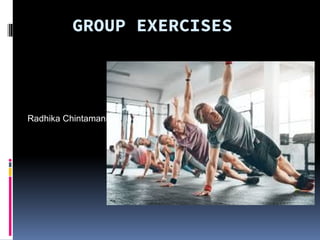Group exercise
- 2. CONTENTS Definition Values of group exercise Difference between individual and group exercises Organization of group exercise: selection of patients, gradings of groups, explanation of the patient, the number of patients in a group and the technique of instruction. Merits of group exercise Demerits of group exercise
- 3. DEFINITION Exercise: it is a subcategory of physical activity that is planned, structured, repetitive and purposeful in the sense that the improvement or maintenance of one or more components of physical fitness is the objective. - W.H.O Individual exercise: defined by individual subject doing exercise either by himself or under supervision of a physiotherapist. Group Exercise: defined by group of people performing a determined set of exercise under the supervision of a physiotherapist.
- 4. NOTE ON GROUP EXERCISE Group exercise: Homogenous group members Consists of 6-8 subjects Individual concentration Stimulation is utilized from working with each other Mass exercise: Heterogenous group members Large number of population Formal word or command or a rhythm dictated by the instructor to the entire mass Stimulation is utilized by the rhythm/formal word/command given by the instructor. Group exercise is very much different from Mass exercise.
- 5. VALUES OF GROUP EXERCISE 1. The patient learns to take responsibility for his own exercise during the group exercise therapy which helps towards adequate home practice. Patients treated individually. The amount of attention given to the individual patient decreases in proportion to the number in the group, and yet a measure of help, supervision and encouragement is available when required. 2. The patient learns to work with others and no longer considers himself set apart from his fellow members because of his disability.
- 6. 3. The patient is given confidence in the treatment and is therefore stimulated to further effort, as progress on the part of other members of the group does not pass unnoticed. 4. The patient is given confidence in his ability to hold his own with others when the group performs some exercise in union. 5. Effort is stimulated by some activities which call for mild form of competitions. 6. Sometimes group exercises are fun. Patients are helped to forget their disabilities temporarily by objective and game-like activities, which are only possible in group treatment.
- 7. Individual exercise Group Exercise 1. One subject 2. Individual focus 3. Proper attention and help delivered 4. More of a therapy 1. 6-8 subjects 2. Divided focus 3. Divided attention but help delivered whenever necessary 4. More of fun-game
- 8. Organization Of Group Exercise 1. Selection of patients: homogenous subjects with respect to disability, age range, sometimes gender. 2. Grading of groups: groups are formed according to the location and nature of the disability, the age group, gender of the subject and nature and strength of the exercises performed.
- 9. Example for group grading Type of group Type of Subjects Leg C Traumatic injuries; for NWB exercises Leg B Traumatic injuries; for PWB exercises Leg A Traumatic injuries; for full WB exercises and activities leading to final rehabilitation Leg X Non-traumatic conditions for NWB exercises Weight lifting and pulleys Patients needing repetitive resisted exercise for various parts of the body can work simultaneously under the direction of one physiotherapist
- 10. 3. Explanation to the patient: preliminary instructions must be given to patients before joining the group like the purpose of the group exercise with regard to his disability. This will develop her/his confidence If the patients are not confident enough to join the group; it is necessary to advice them to watch the group exercise session which they will be joining; this sometimes will help in development of confidence Instructions regarding exercises and breathing pattern is also given Instruction regarding raising the hand/signaling to the therapist to attain the help is delivered prior to the session
- 11. 4. The number of patients in a group: depends on nature of disability, amount of help required by the subjects during exercises and also on ability of the physiotherapist to manage the group. Usually not more than 6-8 subjects form a group to perform group exercise. 5. The technique of instruction: commands, rhythm or beats of certain frequency, demonstration either manual/pamplet/video of a type of group exercise while performing the exercise.
- 12. Merits of group exercise 1. Build up confidence 2. Stimulates his effort while performing exercises thus; improving endurance as well as strength. 3. Group exercises can be modified to attain the balance and co-ordination in subjects with the respective deficits or even in geriatric group. 4. If performed by geriatric; it build good communication. 5. Builds a mild form of competitive levels while performing.
- 13. Demerits 1. Individualized focus/attention can not be delivered 2. Individualized help can not be delivered. 3. Every subject can not participate 4. Only certain form of exercise can be practiced 5. Small group gives better outcome
- 14. THANK YOU

